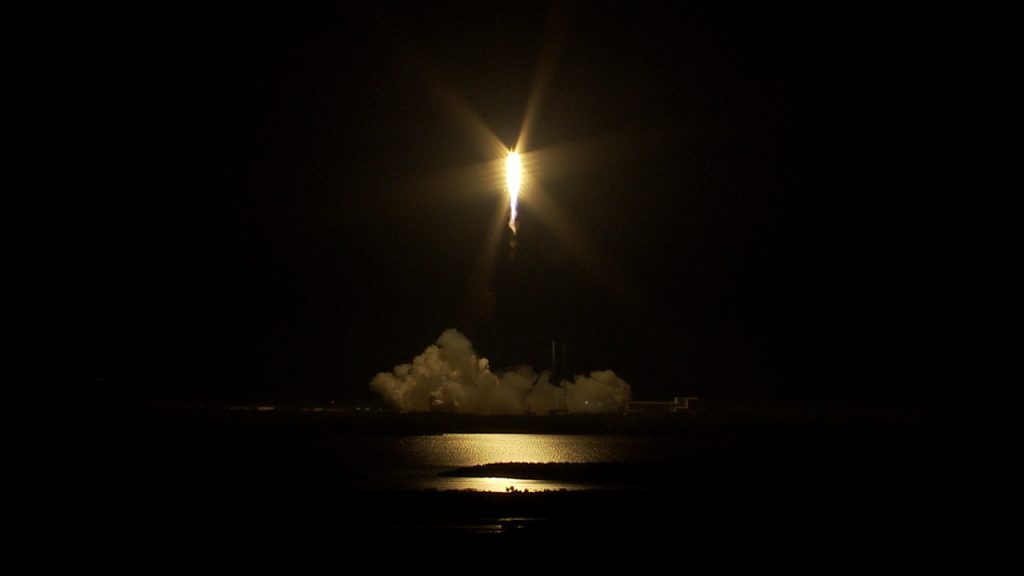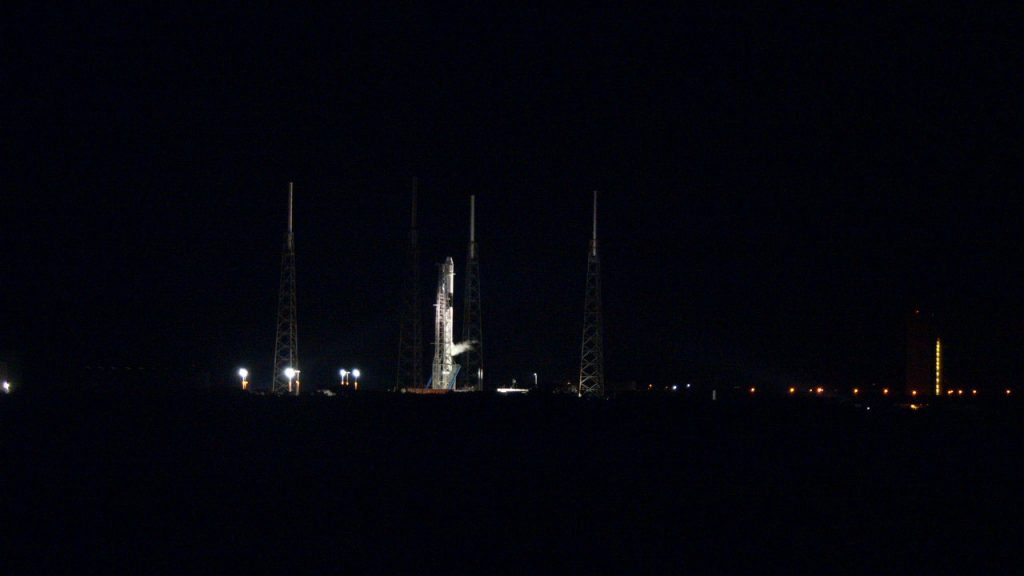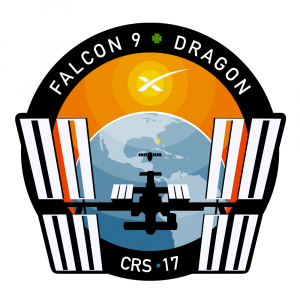The first stage of the Falcon 9 rocket landed successfully on the Of Course I Still Love you drone ship in the Atlantic Ocean.
Category: Kennedy Space Center
Main Engine Cutoff; Second Stage Burn Begins
The Falcon 9 rocket’s first-stage engines have finished their burn and the first stage has separated from the vehicle. As the second stage continues the flight, the first stage will aim for a landing on the Of Course I Love You drone ship in the Atlantic Ocean.
Liftoff! SpaceX CRS-17 on its Way to the Space Station

We have ignition and liftoff at 2:48 a.m. EDT of the SpaceX Falcon 9 rocket and Dragon spacecraft! It is the company’s 17th mission to deliver supplies, equipment and science materials to the International Space Station.
The vehicle is quickly climbing away from Space Launch Complex 40 at Cape Canaveral Air Force Station in Florida.
Ten Minutes to Launch: Things Looking Great
Launch preparations are proceeding smoothly, and everything is on track for liftoff of the SpaceX CRS-17 mission from Space Launch Complex 40 at Cape Canaveral Air Force Station in Florida. Fueling of the Falcon 9 launch vehicle is underway.
Meteorologists with the U.S. Air Force 45th Space Wing predict a 90% chance of favorable weather for liftoff of the SpaceX Falcon 9 rocket. The primary weather concern is ground winds.
The SpaceX Dragon will deliver more than 5,500 pounds of research investigations and equipment, cargo and supplies that will support some of the hundreds of investigations aboard the International Space Station.
NASA Television and the agency’s website are providing live coverage of the launch.
Learn more about station activities by following @space_station and @ISS_Research on Twitter as well as the ISS Facebook and ISS Instagram accounts.
Weather 90 Percent Favorable for Today’s Launch

Meteorologists with the U.S. Air Force 45th Space Wing predict a 90% chance of favorable weather for today’s liftoff of the SpaceX Falcon 9 rocket. The primary weather concerns for launch are the cumulus clouds, thick clouds and flight through precipitation rules.
The launch of SpaceX’s 17th commercial resupply services mission to the International Space Station for NASA is scheduled for 2:48 a.m. EDT with an instantaneous launch window. The Falcon 9 rocket has been moved to its vertical launch position.
Launch coverage will begin at 2:30 a.m., followed at 4 a.m. by a postlaunch news conference with representatives from NASA’s International Space Station Program and SpaceX. The launch and postlaunch news conference will air on NASA Television and the agency’s website.
Packed with more than 5,500 pounds of research, crew supplies and hardware, the SpaceX Dragon spacecraft will launch on a Falcon 9 rocket from Space Launch Complex 40 at Cape Canaveral Air Force Station in Florida.
CRS-17 Gearing Up for Second Launch Attempt

Hello and good morning — again — from NASA’s Kennedy Space Center in Florida. After a drone ship power issue caused a scrub of Friday’s planned 3:11 a.m. EDT launch, a SpaceX Falcon 9 rocket and Dragon spacecraft stand ready for a second attempt today.
Liftoff is targeted for 2:48 a.m. EDT from Space Launch Complex 40 at Cape Canaveral Air Force Station, with an instantaneous launch window. Join us here on the blog and on NASA Television beginning at 2:30 a.m. for updates from the countdown.
Drone Ship Power Issue Forces Scrub of CRS-17 Launch
This morning’s launch attempt has scrubbed due to a drone ship power issue. The next launch opportunity will be at 2:48 a.m. EDT Saturday, May 4.
Launch coverage for the SpaceX CRS-17 mission to the International Space Station will begin at 2:30 a.m. EDT on NASA Television and the agency’s website. A launch of the SpaceX cargo Dragon spacecraft on Saturday will result in its arrival at the space station on Monday, May 6.
Weather Improves for This Morning’s CRS-17 Launch

Hello and good morning from NASA’s Kennedy Space Center in Florida. A SpaceX Falcon 9 rocket and Dragon spacecraft stand ready for liftoff at Space Launch Complex 40 at Cape Canaveral Air Force Station. Launch is targeted for 3:11 a.m. EDT today, with an instantaneous launch window.
Meteorologists with the U.S. Air Force 45th Space Wing predict a 70% chance of favorable weather for liftoff. The primary weather concerns for launch are thick clouds and ground winds.
Launch coverage continues, followed at 4:30 a.m. by a postlaunch news conference with representatives from NASA’s International Space Station Program and SpaceX. The launch and postlaunch news conference will air on NASA Television and the agency’s website.
The spacecraft will take two days to reach the space station before installation on Sunday, May 5. When it arrives, astronaut David Saint-Jacques of the Canadian Space Agency will grapple Dragon, with NASA astronaut Nick Hague serving as backup. NASA astronaut Christina Koch will assist by monitoring telemetry during Dragon’s approach. After Dragon capture, mission control in Houston will send commands to the station’s arm to rotate and install the spacecraft on the bottom of the station’s Harmony module.
SpaceX Falcon 9 and Dragon Poised for Launch

SpaceX’s Falcon 9 rocket is topped by the company’s uncrewed Dragon spacecraft. Dragon is filled with more than 5,500 pound of supplies and payloads, including more than 250 science and research investigations that will take place onboard the International Space Station.
It is not this spacecraft’s first trip to the space station. The CRS-17 Dragon visited the orbiting laboratory in August 2017 during CRS-12.
Read more about the Falcon 9 rocket and the Dragon spacecraft
Launch Day Arrives for SpaceX CRS-17 Mission

Liftoff of a SpaceX Falcon 9 rocket and Dragon spacecraft is targeted for 3:11 a.m. EDT today. Countdown activities are in progress at Space Launch Complex 40 at Cape Canaveral Air Force Station in Florida, where the rocket awaits launch on the company’s 17th commercial resupply mission to the International Space Station.
Be sure to join us here on the blog and on NASA Television beginning at 2:45 a.m. for updates from the countdown. Learn more about the SpaceX CRS-17 mission by going to the mission home page at http://www.nasa.gov/spacex.
